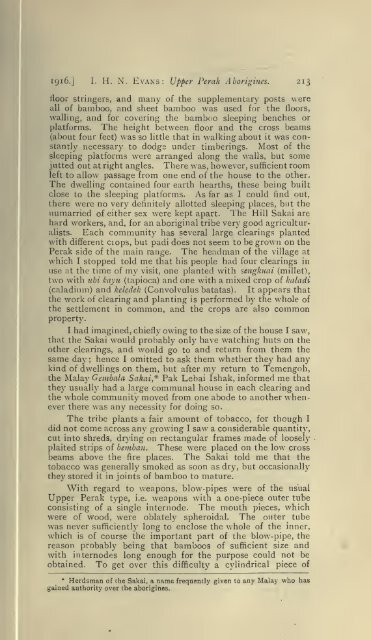Journal of the Federated Malay States museums - Sabrizain.org
Journal of the Federated Malay States museums - Sabrizain.org
Journal of the Federated Malay States museums - Sabrizain.org
You also want an ePaper? Increase the reach of your titles
YUMPU automatically turns print PDFs into web optimized ePapers that Google loves.
1916.] i. H. N. Evans: Upper Perak Aborigines. 213<br />
floor stringers, and many <strong>of</strong> <strong>the</strong> supplementary posts were<br />
all <strong>of</strong> bamboo, and sheet bamboo was used for <strong>the</strong> floors,<br />
walling, and for covering <strong>the</strong> bamboo sleeping benches or<br />
platforms. The height between floor and <strong>the</strong> cross beams<br />
(about four feet) was so little that in walking about it was constantly<br />
necessary to dodge under timberings. Most <strong>of</strong> <strong>the</strong><br />
sleeping platforms were arranged along <strong>the</strong> walls, but some<br />
jutted out at right angles. There was, however, sufficient room<br />
left to allow passage from one end <strong>of</strong> <strong>the</strong> house to <strong>the</strong> o<strong>the</strong>r.<br />
The dwelling contained four earth hearths, <strong>the</strong>se being built<br />
close to <strong>the</strong> sleeping platforms. As far as I could find out,<br />
<strong>the</strong>re were no very definitely allotted sleeping places, but <strong>the</strong><br />
unmarried <strong>of</strong> ei<strong>the</strong>r sex were kept apart. The Hill Sakai are<br />
hard workers, and, for an aboriginal tribe very good agriculturalists.<br />
Each community has several large clearings planted<br />
with different ciops, but padi does not seem to be grown on <strong>the</strong><br />
Perak side <strong>of</strong> <strong>the</strong> main range. The headman <strong>of</strong> <strong>the</strong> village at<br />
which I stopped told me that his people had four clearings in<br />
use at <strong>the</strong> time <strong>of</strong> my visit, one planted with sengkuai (millet),<br />
two with ubi kayji (tapioca) and one with a mixed crop <strong>of</strong> kaladi<br />
(caladium) and keledek (Convolvulus batatas). It appears that<br />
<strong>the</strong> work <strong>of</strong> clearing and planting is performed by <strong>the</strong> whole <strong>of</strong><br />
<strong>the</strong> settlement in common, and <strong>the</strong> crops are also common<br />
property.<br />
I had imagined, chiefly owing to <strong>the</strong> size <strong>of</strong> <strong>the</strong> house I saw,<br />
that <strong>the</strong> Sakai w^ould probably only have watching huts on <strong>the</strong><br />
o<strong>the</strong>r clearings, and w^ould go to and return from <strong>the</strong>m <strong>the</strong><br />
same day; hence I omitted to ask <strong>the</strong>m whe<strong>the</strong>r <strong>the</strong>y had any<br />
kind <strong>of</strong> dwellings on <strong>the</strong>m, but after my return to Temengoh,<br />
<strong>the</strong> <strong>Malay</strong> Gembala Sakai * Pak Lebai Ishak, informed me that<br />
<strong>the</strong>y usually had a large communal house in each clearing and<br />
<strong>the</strong> whole community moved from one abode to ano<strong>the</strong>r whenever<br />
<strong>the</strong>re was any necessity for doing so.<br />
The tribe plants a fair amount <strong>of</strong> tobacco, for though I<br />
did not com.e across any growing I saw a considerable quantity,<br />
cut into shreds, drying on rectangular frames made <strong>of</strong> loosely<br />
plaited strips <strong>of</strong> beniban. These were placed on <strong>the</strong> low cross<br />
beams above <strong>the</strong> fire places. The Sakai told me that <strong>the</strong><br />
tobacco was generally smoked as soon as dry, but occasionally<br />
<strong>the</strong>y stored it in joints <strong>of</strong> bamboo to mature.<br />
With regard to weapons, blow-pipes were <strong>of</strong> <strong>the</strong> usual<br />
Upper Perak type, i.e. weapons with a one-piece outer tube<br />
consisting <strong>of</strong> a single internode. The mouth pieces, which<br />
were <strong>of</strong> wood, were oblately spheroidal. The outer tube<br />
was never sufficiently long to enclose <strong>the</strong> whole <strong>of</strong> <strong>the</strong> inner,<br />
which is <strong>of</strong> course <strong>the</strong> important part <strong>of</strong> <strong>the</strong> blow-pipe, <strong>the</strong><br />
reason probably being that bamboos <strong>of</strong> sufficient size and<br />
with internodfts long enough for <strong>the</strong> purpose could not be<br />
obtained. To get over this difficulty a cylindrical piece <strong>of</strong><br />
• Herdsman <strong>of</strong> <strong>the</strong> Sakai, a name frequently given to any <strong>Malay</strong> who has<br />
gained authority over <strong>the</strong> aborigines.

















